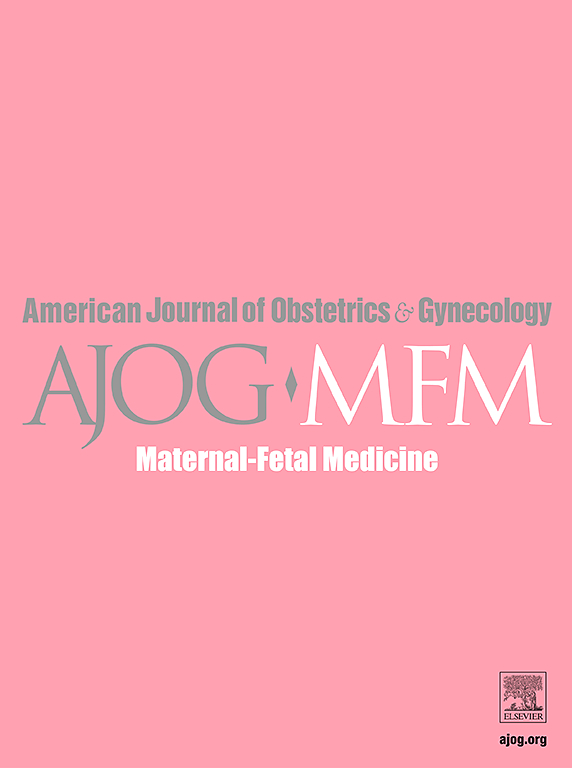妊娠期高血压疾病患者产后快速出院与标准出院的对比及其对产后过程的影响。
IF 3.8
2区 医学
Q1 OBSTETRICS & GYNECOLOGY
American Journal of Obstetrics & Gynecology Mfm
Pub Date : 2024-10-01
DOI:10.1016/j.ajogmf.2024.101475
引用次数: 0
摘要
背景:顺产的住院时间一般为 2 天,剖宫产为 3 天。健康维护组织和第三方支付机构鼓励缩短产妇的住院时间。提前出院的安全性尚不明确,尤其是对妊娠高血压疾病(HDP)患者而言:研究设计:这是一项单一学术中心的回顾性队列研究,研究对象为两个时期的HDP(妊娠高血压、子痫前期或慢性高血压)患者:2015-2018年,实施快速出院政策之前;2019-2020年,在全院范围内实施产后快速出院政策之后。快速出院政策要求患者在阴道分娩后第 1 天和剖宫产后第 2 天尽快出院回家。主要结果是产后非计划医疗使用情况,即急诊室就诊、计划外就诊和再次入院。次要结果是产后计划内就诊人次、出院后开始服用降压药以及第一年的血压控制情况。我们进行了二变量和多变量逻辑回归分析,以评估快速出院与主要和次要结果之间的关联:共有 1,441 名患者参与了分析。产后标准出院组和快速出院组的非计划医疗使用率差异无统计学意义(标准产后出院组为 11.3%,快速出院组为 13.8%,P=0.17)。两组患者在产后 1-2 周、6 周和 1 年的收缩压和舒张压没有差异。快速出院组患者更有可能参加产后 1-2 周的血压检查(58.7% 对 51.7%,P=0.02,调整 OR 1.33,95% CI 1.08-1.77)。其他次要结果在两组之间没有差异:在这项单一学术中心研究中,HDP 患者产后加速出院与产后非计划医疗使用率较高无关。本文章由计算机程序翻译,如有差异,请以英文原文为准。
Expedited versus standard postpartum discharge in patients with hypertensive disorders of pregnancy and its effect on the postpartum course
Background
Hospital stay after an uncomplicated delivery is typically 2 days for vaginal birth and 3 days for cesarean birth. Health maintenance organizations and third-party payers have encouraged shorter maternity stays. The safety of earlier discharge is unclear particularly when it comes to patients diagnosed with hypertensive disorders of pregnancy (HDP).
Objective
To examine whether expedited discharge amongst patients with HDP will have a negative effect on postpartum readmission rate and blood pressure related complications.
Study design
This was a single academic center retrospective cohort study of patients with HDP (gestational hypertension, preeclampsia, or chronic hypertension) for 2 epochs: 2015–2018, prior to implementation of an expedited discharge policy, and 2019–2020 after hospital wide implementation of expedited postpartum discharge. The expedited discharge policy entailed patients being discharged home as soon as day 1 after a vaginal delivery and day 2 after a cesarean delivery. The primary outcome was unplanned health care utilization postpartum, defined as emergency department (ED) visits, unscheduled clinic visits, and hospital readmission. Secondary outcomes were planned postpartum visits attendance, antihypertensive medication initiation after discharge, and blood pressure control throughout the first year. Bivariable and multivariable logistic regression analyses were run to evaluate the association between expedited discharge and primary and secondary outcomes.
Results
A total of 1,441 patients were included in the analysis. There were no statistically significant differences in the rate of unplanned health care utilization (11.3% in the standard postpartum discharge group vs. 13.8% in the expedited discharge group, P=.17). Systolic and diastolic blood pressures did not differ between the groups at 1–2 weeks, six weeks, and one year postpartum. Patients in the expedited discharge group were more likely to attend the 1–2-week postpartum blood pressure check (58.7% vs. 51.7%, P=.02, adjusted OR 1.33, 95% CI 1.08–1.77). Other secondary outcomes did not differ between the two cohort groups.
Conclusion
In this single academic center study, expedited discharge after delivery in patients with HDP was not associated with a higher rate of unplanned healthcare utilization postpartum.
求助全文
通过发布文献求助,成功后即可免费获取论文全文。
去求助
来源期刊

American Journal of Obstetrics & Gynecology Mfm
Medicine-Medicine (all)
CiteScore
7.40
自引率
3.20%
发文量
254
审稿时长
40 days
期刊介绍:
The American Journal of Obstetrics and Gynecology (AJOG) is a highly esteemed publication with two companion titles. One of these is the American Journal of Obstetrics and Gynecology Maternal-Fetal Medicine (AJOG MFM), which is dedicated to the latest research in the field of maternal-fetal medicine, specifically concerning high-risk pregnancies. The journal encompasses a wide range of topics, including:
Maternal Complications: It addresses significant studies that have the potential to change clinical practice regarding complications faced by pregnant women.
Fetal Complications: The journal covers prenatal diagnosis, ultrasound, and genetic issues related to the fetus, providing insights into the management and care of fetal health.
Prenatal Care: It discusses the best practices in prenatal care to ensure the health and well-being of both the mother and the unborn child.
Intrapartum Care: It provides guidance on the care provided during the childbirth process, which is critical for the safety of both mother and baby.
Postpartum Issues: The journal also tackles issues that arise after childbirth, focusing on the postpartum period and its implications for maternal health. AJOG MFM serves as a reliable forum for peer-reviewed research, with a preference for randomized trials and meta-analyses. The goal is to equip researchers and clinicians with the most current information and evidence-based strategies to effectively manage high-risk pregnancies and to provide the best possible care for mothers and their unborn children.
 求助内容:
求助内容: 应助结果提醒方式:
应助结果提醒方式:


